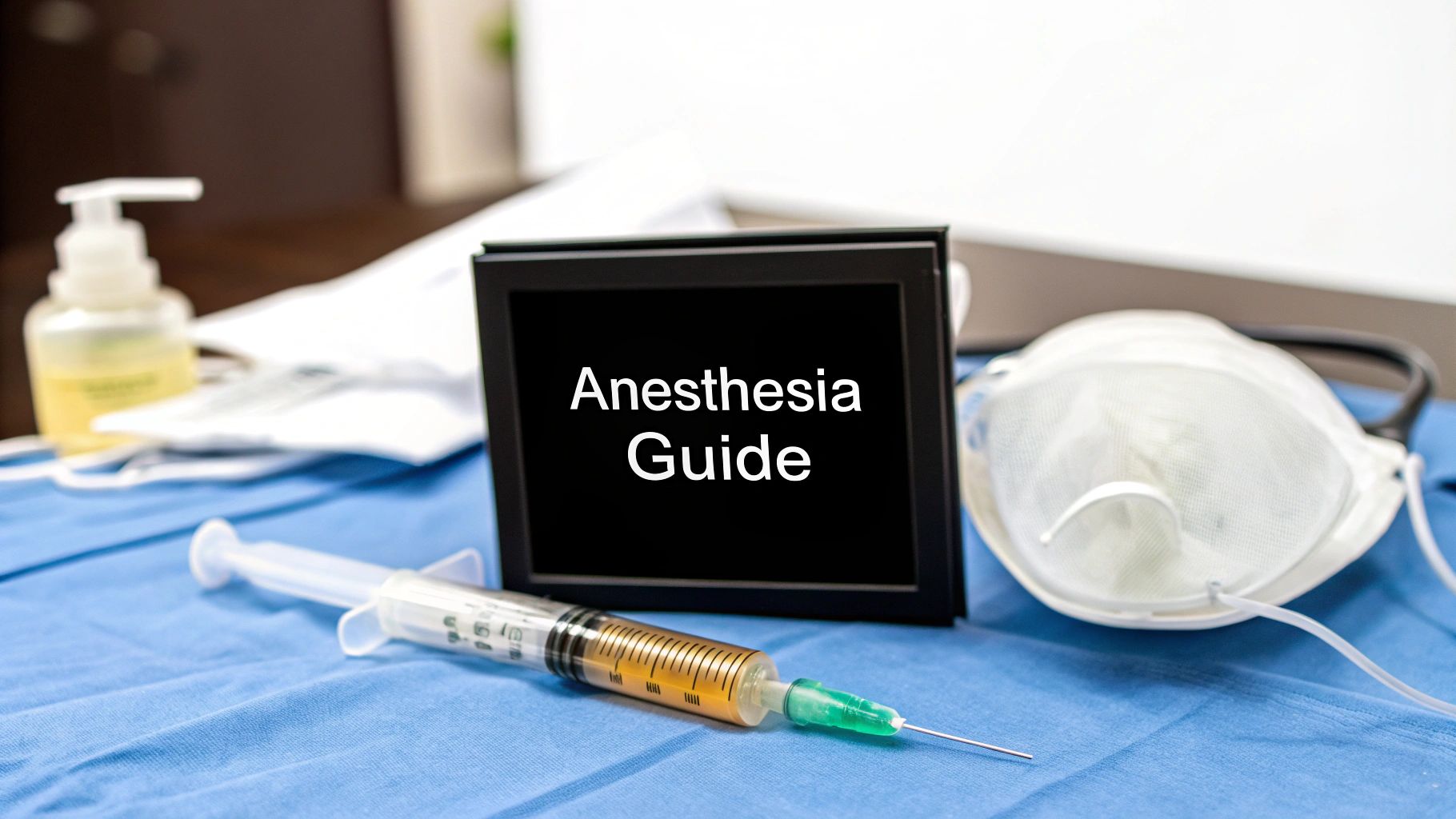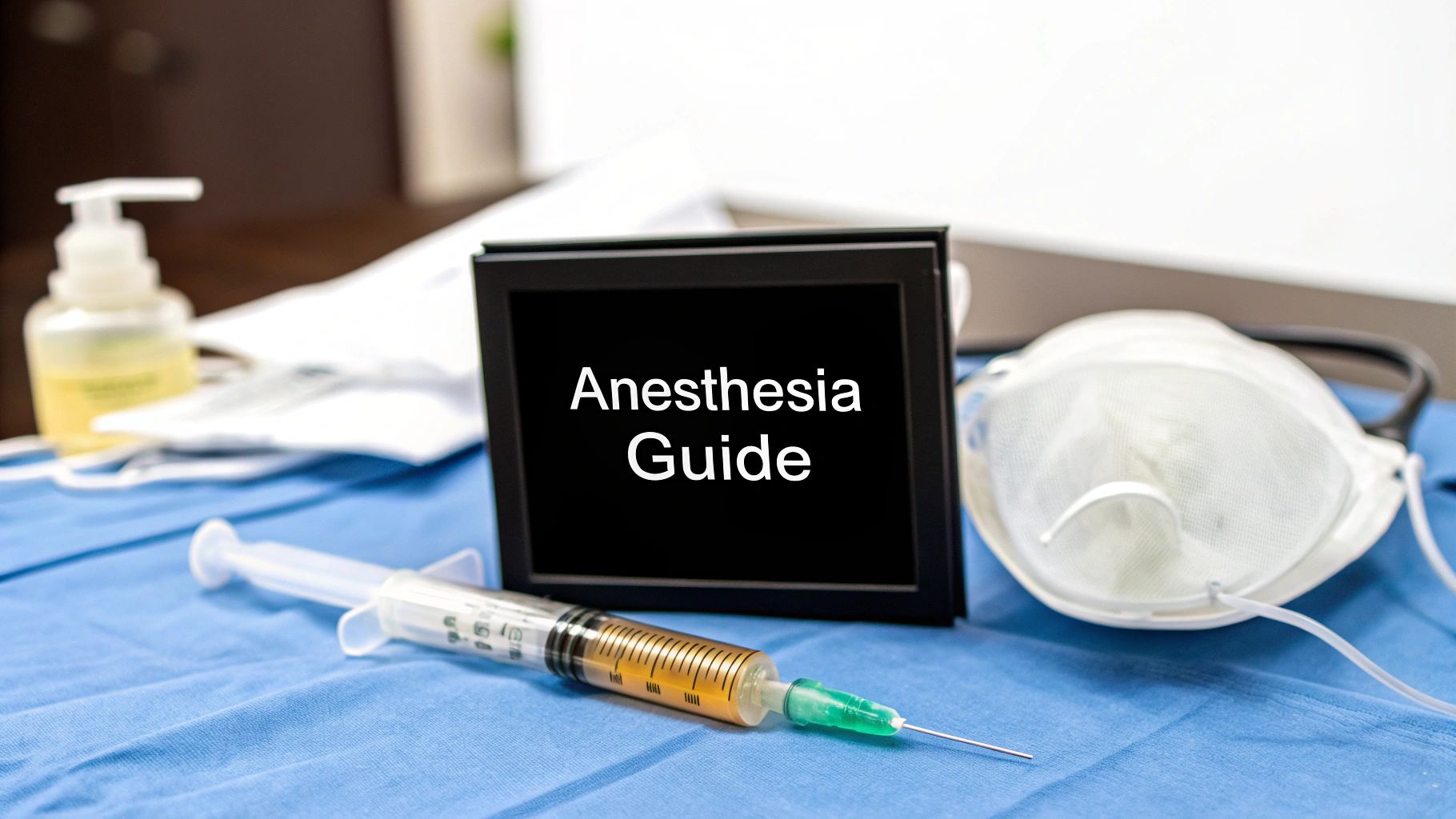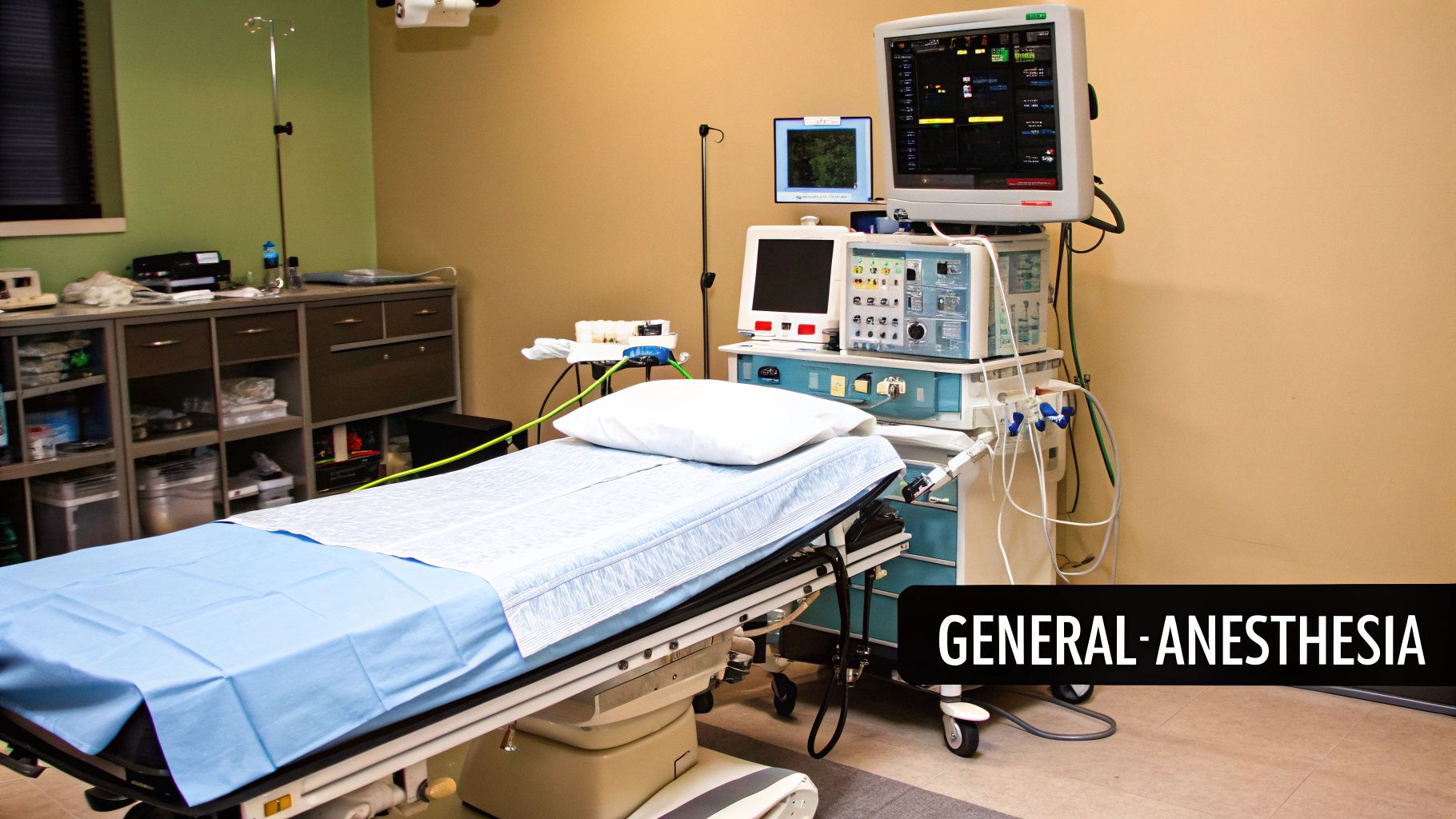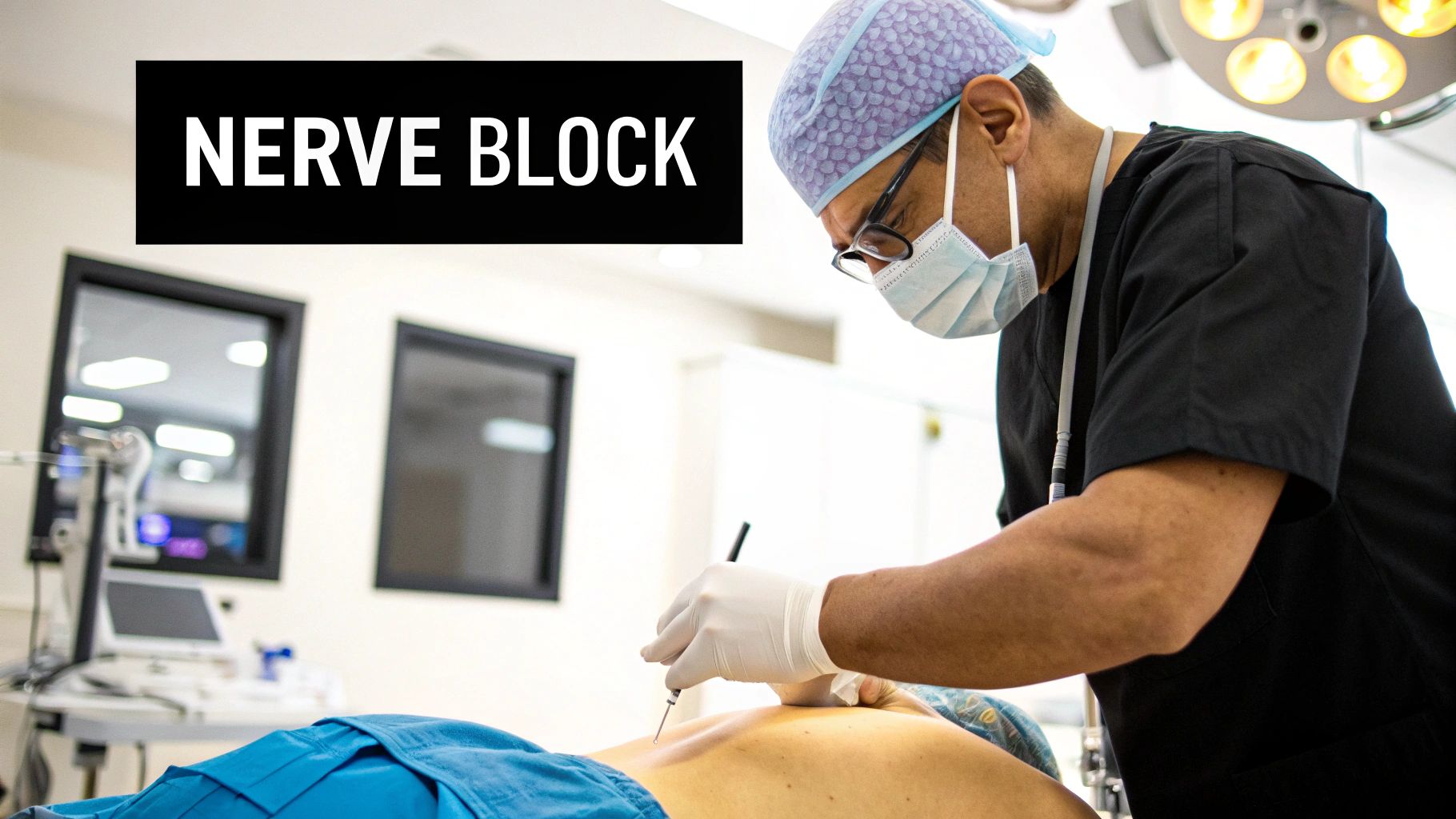
October 12, 2025
Anesthesia Types for Surgery A Patient's Guide
Discover the main anesthesia types for surgery. This guide explains general, regional, local, and sedation to help you prepare for your procedure.
Oct 12, 2025

When you hear the word "anesthesia," what comes to mind? For most people, it’s the idea of being completely "put to sleep" for a major operation. While that's one type, the world of anesthesia is actually much broader, with four main categories designed to keep you safe and comfortable.
These options—general, regional, local, and sedation—are all tools in your surgeon's and anesthesiologist's toolkit. The right choice for you depends entirely on the type of surgery you're having, your overall health, and what you and your medical team decide is best.
Think of anesthesia as a spectrum. On one end, you have a simple numbing injection for a tiny spot, and on the other, you have a carefully controlled state of unconsciousness for a complex procedure. It's all about matching the level of pain control and awareness to the specific needs of the surgery.
This is a crucial part of the surgical planning process. It's not just about preventing pain; it’s about ensuring the entire experience is as smooth and stress-free as possible. You might be fully awake but unable to feel a thing in one area, or you might be in a light, dreamy state, barely aware of your surroundings.
This visual gives you a great at-a-glance overview of how these different types work.

As you can see, the main difference lies in how much of the body is affected—from the entire system with general anesthesia down to a very precise, localized spot.
To make things even clearer, let's break down the four main types in a simple table. This will help you quickly see how they differ in terms of your awareness, the area they affect, and when they're most often used.
Understanding these basics is the first step in feeling confident about your upcoming procedure. When you know what to expect, the whole process feels much more manageable and far less intimidating.
This knowledge forms the foundation of surgical safety, a topic we explore more deeply in our post about how we ensure plastic surgery is safe. If you're interested in diving deeper into various health topics from different experts, you might also find valuable information on Salthea's blog for health insights.
When most people picture surgery, they're thinking of general anesthesia. This is the big one—a carefully managed state of complete unconsciousness where you're totally unaware, feel no pain, and won't remember the procedure afterward. It's best to think of it not as a coma, but as a deep, medically induced sleep that is completely reversible.
The whole point is to keep you perfectly still and comfortable, which is essential for complex or long surgeries. To get you there, anesthesiologists use a precise cocktail of medications, customized just for you and the specific operation you're having.

General anesthesia is really the bedrock of modern surgery, making intricate procedures possible that would be unthinkable otherwise. Its reliability and safety are why it's so widely used. In fact, the global market for general anesthesia drugs was valued at around USD 5.29 billion and is expected to grow to about USD 6.56 billion by 2030. If you're interested, you can explore more data on the general anesthesia market to see just how integral it is to healthcare.
Getting you into that state of deep sleep happens in one of two ways. Your anesthesiologist will choose the best method based on your medical history and the type of surgery you're having.
Once you're "under," your anesthesiologist is by your side for the entire duration, acting as your personal guardian.
Throughout the surgery, your anesthesiologist meticulously monitors your heart rate, blood pressure, breathing, and oxygen levels. They constantly fine-tune the anesthetic medications to keep you safely and comfortably unconscious until the very end of the procedure.
General anesthesia is the top choice for major operations where it's absolutely critical for you to be completely still and unaware for both safety and success.
You can almost always expect it for procedures that are:
When the surgery is over, your anesthesiologist carefully reverses the medications, allowing you to wake up slowly and gently in a recovery room. It's common to feel a bit groggy or nauseous, and maybe have a sore throat, but these side effects are usually mild and the medical team will be right there to help manage them.
Think of regional anesthesia as a strategic approach to pain management. While general anesthesia is like turning off the main power switch to your entire body, regional anesthesia is far more precise. It's like an expert electrician flipping the circuit breaker for just one specific area—a single limb or the lower half of your body—while leaving everything else on.
The goal here is to block sensation in a targeted region by injecting medication near a major nerve or a bundle of nerves. This "nerve block" essentially intercepts pain signals before they can travel to your brain. You remain comfortable, awake (or lightly sedated), and pain-free for the procedure without the full-body experience of being put completely to sleep.

You've probably heard of regional anesthesia without even realizing it. The exact technique your anesthesiologist uses will depend entirely on the surgical site and what needs to be numbed.
Here are two of the most recognizable types:
The real beauty of regional anesthesia is that it offers fantastic pain control not just during the surgery, but for hours afterward. Many people find they need significantly fewer opioid painkillers in their initial recovery because the numbing effect has such a long-lasting impact.
A huge plus for regional anesthesia is a smoother, more comfortable recovery. Patients often sidestep the common side effects of general anesthesia, like postoperative nausea and that lingering groggy feeling.
Because you're not fully unconscious, you also don't need a breathing tube, which helps avoid a sore throat after surgery. This approach places less overall stress on your body, making it a great choice for many orthopedic procedures on knees, shoulders, and hands, as well as some operations on the lower abdomen. It strikes a perfect balance between powerful pain relief and a quicker return to feeling like yourself again.
Let’s move on to the types of anesthesia you're most likely to encounter for less invasive procedures. Local anesthesia is probably the one you already know, even if you’ve never had surgery. It’s the ultimate specialist, designed to numb a very small, specific part of your body while you stay completely awake.
Think about a dental filling or having a single mole removed. The goal isn't to put you to sleep, but simply to block pain signals from that one tiny spot. It's usually done with a quick injection right where the work needs to be done, making it a super safe and straightforward choice for minor, in-office procedures.

This kind of precision is a big part of why it's so common. The global market for all anesthesia drugs, including locals, was valued at around USD 7.24 billion and is expected to grow to USD 9.61 billion by 2033. If you're curious, you can discover more insights about the anesthesia drug market to see how each type plays a role in modern medicine.
But what happens when you need a bit more than just numbing? What if it’s the anxiety of the procedure itself that’s the main hurdle? This is where sedation steps in. You’ve probably heard it called "twilight sleep," and it uses IV medications to guide you into a state of deep relaxation.
The crucial difference from general anesthesia is that you aren't actually unconscious. You’re breathing on your own and can often respond to a gentle nudge or a simple question. The best part? You'll feel calm, sleepy, and likely won't remember much, if anything, about the surgery afterward.
Sedation is not a one-size-fits-all approach. Your anesthesiologist can carefully adjust the medication to achieve different levels of relaxation, ensuring you receive the exact amount of comfort needed for your specific procedure.
This fine-tuning ability makes sedation incredibly versatile. We can dial it up or down to provide just the right amount of calm, from a light, anxiety-reducing touch to a much deeper state of rest.
To hit that perfect sweet spot of comfort and safety, sedation is typically broken down into three levels. The one we choose depends entirely on the surgery you’re having and your own personal comfort needs.
Often, we’ll combine sedation with local or regional anesthesia. This combination is a fantastic way to ensure you are both physically comfortable and mentally calm. It’s a go-to strategy for procedures like colonoscopies, cataract surgery, and certain cosmetic surgeries where being fully unconscious isn't necessary, but being completely comfortable is the top priority.
https://www.youtube.com/embed/aPlN4gORI7g
Deciding which type of anesthesia is right for your surgery isn't a random choice. Your anesthesiologist is like a master strategist, carefully building a plan that’s tailored specifically to you, your health, and the demands of your procedure. It's not a one-size-fits-all approach; it’s a bespoke plan designed for your safety and comfort.
This all happens through a close collaboration between you, your surgeon, and your anesthesiologist. We look at every detail, from the type of surgery and how long it’s expected to take, to your complete medical history—allergies, past reactions to anesthesia, and any health conditions you might have. Your own comfort level and preferences are a big part of that conversation, too.
The technology supporting us is just as sophisticated. The global market for anesthesia machines was valued at about USD 11.1 billion and is projected to climb to nearly USD 17.7 billion by 2033. This growth highlights just how central this technology is to modern surgical safety. You can read the full research about the anesthesia machine market to get a sense of the incredible engineering that goes into your care.
When building your plan, your care team weighs several key elements to land on the safest and most effective strategy for you.
The Surgery Itself: Is it a quick, minimally invasive procedure or a complex, hours-long operation? The anesthesia for a minor touch-up is worlds away from what's needed for major reconstructive surgery.
Your Overall Health: We need the full picture. This includes any heart conditions, lung issues like asthma, or chronic illnesses such as diabetes that could influence how your body responds.
Previous Anesthesia Experiences: Ever felt nauseous after a past surgery? Knowing this ahead of time lets the team get ahead of potential side effects and make your recovery smoother.
Medications and Allergies: A complete list of everything you're taking—prescriptions, over-the-counter meds, and even herbal supplements—is critical to prevent any negative interactions.
An anesthesia plan isn't set in stone. It's a living thing. Your anesthesiologist is watching over you moment-to-moment during the procedure, ready to make tiny adjustments to keep you safe, stable, and comfortable from beginning to end.
To really see how this works, let’s look at two completely different patients.
Patient A: A healthy 30-year-old having a quick arthroscopic knee surgery. For this patient, a regional anesthetic like a spinal block is a fantastic option. We might add a little light sedation to help them relax, but the targeted pain control means fewer side effects for the rest of their body.
Patient B: A 70-year-old with a history of heart disease who is scheduled for a lengthy abdominal operation. Here, general anesthesia is the only way to go. It guarantees the patient remains completely still and gives the anesthesiologist total control over their breathing and vital signs—which is absolutely essential given their medical history and the complexity of the surgery.
This kind of personalized planning is what modern medical care is all about. It’s particularly vital in settings with dedicated operating rooms, which you can learn more about by reading about the role of on-site surgical suites in patient safety. Your pre-op consultation is the perfect time to ask questions, share your concerns, and be an active partner in your own care.
Getting a handle on the different types of anesthesia is a huge part of feeling ready for your procedure, but what you do to prepare your body and mind is just as crucial for a successful outcome. Your surgical team will give you a specific set of instructions—it's absolutely vital you follow them to the letter for your own safety.
One of the most important rules you'll hear is about fasting. This means no food or drink for a set number of hours before you head to the hospital. It might seem like a small thing, but it's a major safety step. Fasting prevents aspiration, a dangerous complication where food or liquid could get into your lungs while you're under anesthesia.
After your procedure wraps up, you'll be taken to a special recovery area called the post-anesthesia care unit, or PACU. Think of it as a quiet, safe space where a dedicated nursing team keeps a close eye on you as the anesthesia slowly wears off.
It’s completely normal to feel groggy, maybe a little confused, or even start shivering as your body comes back online. These are just temporary side effects. The PACU team is there to manage any pain or discomfort and make sure you wake up as smoothly and comfortably as possible.
Beyond the basics, true preparation involves a holistic look at your health. This is the time to talk with your doctor about everything from your current medications to what supplements, like vitamin C, to consider before surgery.
For a complete rundown of what to expect and how to get ready, our guide on how to prepare for surgery is packed with practical advice. Following these steps helps lay the groundwork for a smoother, easier recovery from start to finish.
It’s completely normal to have questions—and maybe a few jitters—about anesthesia before your surgery. Let's walk through some of the most common concerns patients bring up, so you can feel more prepared and at ease.
This is probably the number one fear people have, but rest assured, it’s incredibly rare. This event, called anesthesia awareness, has become almost unheard of thanks to the sophisticated monitoring we use today.
Your anesthesiologist is like a dedicated pilot for your body during the procedure. They are constantly watching your vital signs—brain activity, heart rate, breathing, and blood pressure—on a bank of monitors. This allows them to make tiny, real-time adjustments to your anesthesia, ensuring you stay safely and completely unconscious from start to finish.
Most side effects are pretty mild and don't last long. Think of them as the temporary after-effects of your body hitting the "pause" button.
Our team is always ready to help manage any of these symptoms to make sure you're as comfortable as possible during your initial recovery.
The choice of anesthesia is always a team decision. Your anesthesiologist will sit down with you, explain the pros and cons of each option, and recommend the best and safest plan for your specific procedure and health needs.
The timeline really depends on the type of anesthetic used, the length of your surgery, and how your own body processes the medication.
As a general guide, local anesthesia usually fades within a few hours. Regional blocks are designed to last longer, sometimes for 12-24 hours, which is a huge benefit for managing post-op pain. After general anesthesia, you’ll wake up in the recovery room shortly after surgery, but it might take a full day before you feel completely like yourself again.
Your input is absolutely vital, but the final call is a medical decision made in partnership with your anesthesiologist.
They'll take everything into account: the type of surgery you're having, your overall health, any past experiences with anesthesia, and of course, your personal comfort. The goal is to find that perfect balance—the safest, most effective option that also aligns with your preferences. You are always an active participant in that conversation.
At Cape Cod Plastic Surgery, Dr. Fater and our expert team are committed to ensuring your safety and comfort throughout your entire surgical journey. Learn more about our approach to patient care.

October 12, 2025
Discover the main anesthesia types for surgery. This guide explains general, regional, local, and sedation to help you prepare for your procedure.

October 11, 2025
Learn the key differences between hydrafacial vs regular facial to choose the right treatment for glowing, healthy skin. Read our expert guide now!

October 10, 2025
Explore the best treatments for sagging skin, from non-invasive to surgical options. Find the perfect solution to restore your youthful appearance.